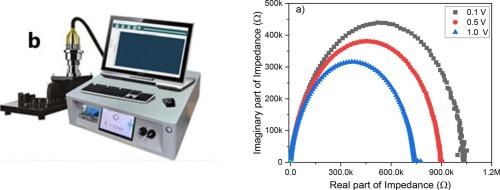Voltage-dependent dielectric organic semiconductor polyaniline by Yakuphanoglu dielectric method
IF 2.4
3区 化学
Q4 CHEMISTRY, PHYSICAL
引用次数: 0
Abstract
Nanostructured polyaniline (PANI) was prepared by in-situ oxidative polymerisation of aniline using ammonium persulfate as oxidant. The synthesized nanostructured polyaniline was investigated by spectroscopic, morphological, electrical and dielectric methods. The nanostructured polyaniline was confirmed by FT-IR, XRD and SEM analyzes. The dielectric properties such as dielectric constant, dielectric loss, dielectric loss factor, AC conductivity, impedance, admittance and Cole–Cole plots for nanostructured polyaniline were analyzed as a function of frequency between 0.1 V and 5.0 V and at room temperature. Nanostructured PANI was found to change the direction of the phase angle above 2 V and after about 2 kHz. The voltage applied to nanostructured polyaniline was found to have an effect on the electrical and dielectric properties. The increase in the dielectric constant measured at room temperature with increasing voltage facilitates the orientation of electrons and increases the polarization associated with the movement of electrons. The dielectric parameters of nanostructured PANI showed that they can be controlled by an applied DC voltage. In this respect, nanostructured PANI is a voltage-dependent dielectric (VDD) material and can be significantly utilized in dielectric applications for capacitors.

Yakuphanoglu介电法制备电压依赖性介电有机半导体聚苯胺
以过硫酸铵为氧化剂,对苯胺进行原位氧化聚合法制备了纳米聚苯胺。采用光谱学、形态学、电学和介电等方法对合成的纳米聚苯胺进行了表征。通过FT-IR、XRD和SEM分析证实了所制备的纳米聚苯胺。分析了室温下纳米聚苯胺的介电常数、介电损耗、介电损耗因子、交流电导率、阻抗、导纳和Cole-Cole图等介电性能随频率在0.1 V ~ 5.0 V范围内的变化规律。发现纳米结构的聚苯胺在2v以上和2khz后可以改变相角方向。施加在纳米结构聚苯胺上的电压对其电学和介电性能有影响。在室温下测量的介电常数随着电压的增加而增加,有利于电子的取向,并增加与电子运动相关的极化。纳米结构聚苯胺的介电参数可以通过施加直流电压来控制。在这方面,纳米结构聚苯胺是一种电压依赖性介电(VDD)材料,可以在电容器的介电应用中得到显著利用。
本文章由计算机程序翻译,如有差异,请以英文原文为准。
求助全文
约1分钟内获得全文
求助全文
来源期刊

Chemical Physics
化学-物理:原子、分子和化学物理
CiteScore
4.60
自引率
4.30%
发文量
278
审稿时长
39 days
期刊介绍:
Chemical Physics publishes experimental and theoretical papers on all aspects of chemical physics. In this journal, experiments are related to theory, and in turn theoretical papers are related to present or future experiments. Subjects covered include: spectroscopy and molecular structure, interacting systems, relaxation phenomena, biological systems, materials, fundamental problems in molecular reactivity, molecular quantum theory and statistical mechanics. Computational chemistry studies of routine character are not appropriate for this journal.
 求助内容:
求助内容: 应助结果提醒方式:
应助结果提醒方式:


